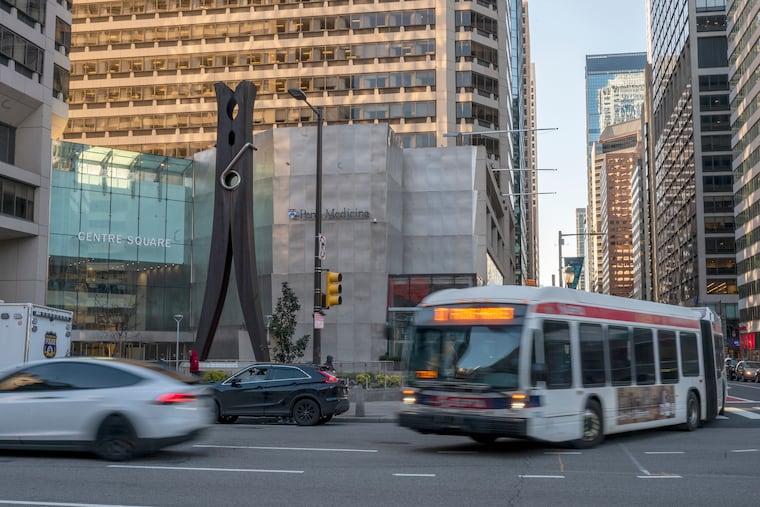Philadelphia’s office buildings have lost over $1 billion in assessed value
Fewer workers in buildings means lost tax revenue to the city from food and beverage sales, wages, and the buildings themselves.

The assessed value of Center City office buildings fell by over $1 billion in recent years, the Office of Property Assessments (OPA) reported to City Council on Monday afternoon. That spells trouble for the City of Philadelphia’s tax revenue.
The assessed value fell from $9.82 billion in tax year 2023 to $8.78 billion in tax year 2025, OPA stated, amid persistent office vacancies and recent transactions that have seen buildings selling for far below their previously assessed value.
“There are a lot of buildings in Center City that are considered to be distressed, and a number of buildings that are in bankruptcy,” said Councilmember Jeffery Young Jr., who called the hearing and represents much of the Center City office district. “Our tax base depends on Center City.”
Center City’s vacancy levels have been around 20% for over a year — more than double pre-pandemic rates — as many firms downsize their office space for the era of hybrid work.
That means lost taxes on food and beverage sales downtown as well as less wage tax paid by workers who live in the suburbs and a smaller service sector workforce. Real estate transfer tax dollars downtown have shriveled, too, as few buildings have changed hands since the pandemic and those that have commanded substantially smaller asking prices than they did when last sold.
But the potentially biggest blow to the city is from falling commercial real estate property tax revenues as owners challenge their valuations.
Take 1500 Spring Garden, a 13-story office building near Broad Street, whose owners appealed its assessed value from $192 million in 2022 to $76 million in 2025. The Building Owners and Managers Association (BOMA) estimates that the city will lose almost $4 million annually on that property alone.
“Make no mistake: The Philadelphia commercial office market and the city as a whole is at a critical inflection point,” said Brent Hutchinson, CEO of OPEX CRE Management and chair of BOMA Philadelphia. “Employee return-to-office is presently not at viable levels.”
What’s behind the vacancy crisis
The City of Philadelphia has required its workforce to return to the office five days a week in the summer, while other major employers including Comcast and transit agency SEPTA have their workers back four days a week. But many employers require three days a week or less, shrinking office space needs.
As pre-pandemic or early pandemic era leases expire, Philadelphia isn’t losing many office tenants to the suburbs or to other markets. Existing employers are simply using less space. Tenants renewing contracts are leasing between 25% and 40% less space, Hutchinson estimated, with 2025 anticipated to be a peak year for lease expirations.
“With persistent tenant downsizings in the wake of changing space utilization patterns and anemic tenant attraction activity from outside the market, we anticipate [increasing vacancy] to continue,” said Lauren Gilchrist, chief of commercial real estate services firm Newmark’s Greater Philadelphia office.
According to the estimates of the business advocacy group Center City District, in comparison with 2019, only 63% of daily office worker foot traffic has returned to the core of downtown’s office district along West Market Street and John F. Kennedy Boulevard.
“It’s worth noting that this number continues to grow,” said Prema Katari Gupta, CEO of Center City District. “Thanks to the leadership of our mayor and companies like Comcast and IBX, there are approximately 6% more nonresident workers in the office district than there were at this time last year. We expect this number to continue to inch upward.”
Philadelphia’s top “trophy” office buildings like the FMC or Comcast towers, meanwhile, are 89% occupied as tenants downsize and can afford nicer space. That’s a silver lining, as is Center City’s continued residential boom.
Although preliminary Census estimates show Philadelphia’s overall population shrinking for the first time since 2005, downtown and its surrounding neighborhoods continue to add population. The restaurant and retail sectors are healthier than many peer cities as a result.
“Over the past couple of years, I’ve been to Denver, I’ve been to Oakland, and I would say that our downtown is faring much better than other cities I’ve seen,” Councilmember Jamie Gauthier said at Monday’s Committee of Commerce and Economic Development hearing. “Those cities felt very empty to me, even a few years out of the pandemic.”
About 1.5 million square feet of office-to-residential conversions are in the pipeline, adding to the almost 10 million square feet that were converted pre-pandemic. That highlights the flexibility of zoning in Center City, which allows most conversions, and the 10-year property tax abatement for adaptive reuse projects.
Real estate industry advocates at the hearing only gestured broadly at ideas for incentivizing new conversions, and Philadelphia’s flexible zoning and generous tax incentives were not acknowledged. In terms of attracting new employers, Hutchinson of BOMA recommended tax incentives for companies that hire Philadelphia residents or wage tax rebates for residents who work for city-based employers — ideas that could run afoul of the uniformity clause.
The possibility of rethinking the city’s tax structure, specifically reducing reliance on the wage tax, was little discussed although it likely will be a topic of debate at a forthcoming Tax Reform Commission.
Without some major change to attract new employers, industry insiders fear that the office sector will continue to stagnate and undermine Philadelphia’s tax base and future economic growth. Currently, 10.4% of commercial mortgage-backed security loans in the city are in distress, BOMA reports, on top of the losses that lenders have already seen this summer.
“When investors lose money in real estate, they become more reticent to invest in the same location again … creating even more challenges to attracting the non-Philadelphia-based capital that Philadelphia so desperately needs,” Gilchrist said.